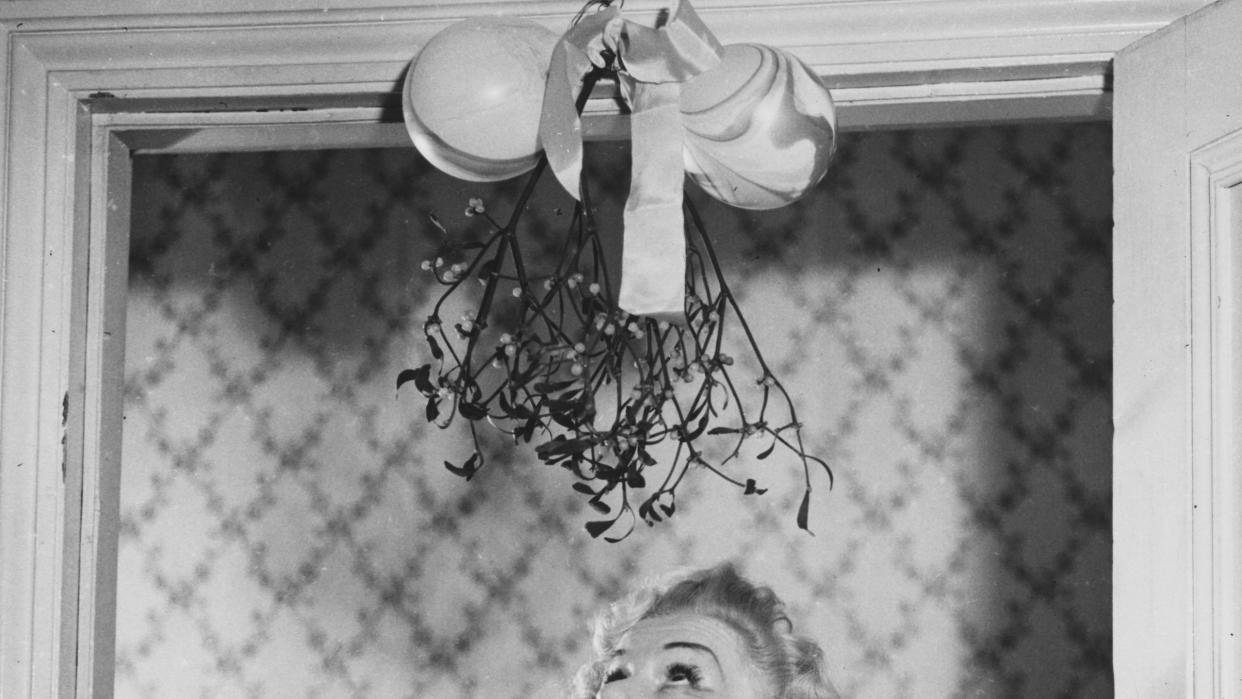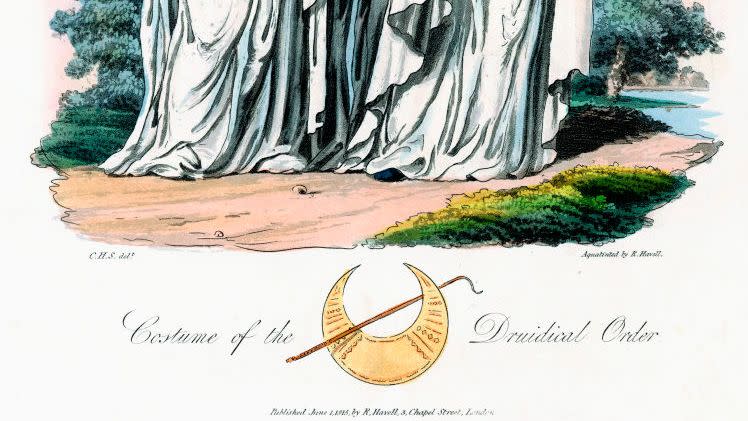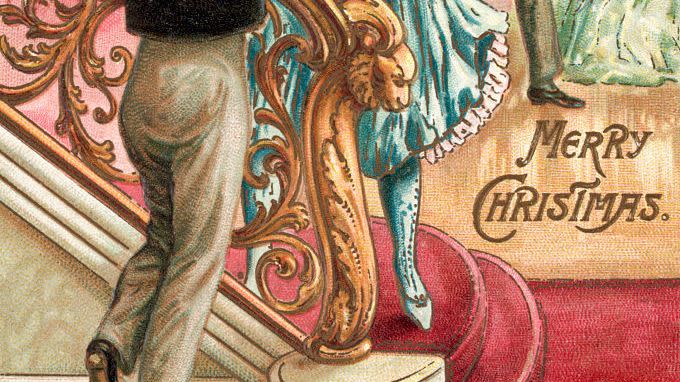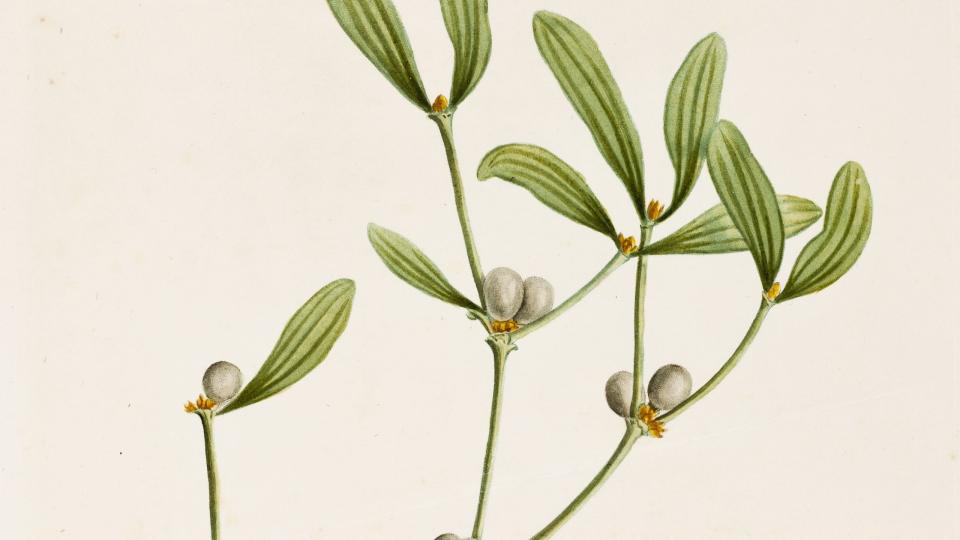Pucker Up! This Is Why We Kiss Under the Mistletoe at Christmas

"Hearst Magazines and Yahoo may earn commission or revenue on some items through these links."
We all know that little green sprig that hangs above doorways during the holiday season, inviting amorous encounters, premature propositions, and, occasionally, an excuse to run the hell out of the room. And while many of us associate the white-berried boughs with Christmas, smooching, and a Jackson 5 song (if not Harry Potter’s first kiss), the history of mistletoe and how it became incorporated into holiday lore remains largely unknown.
Why do fairly freethinking folks find themselves following orders from a parasitic (yes!) shrub come December? When did standing under mistletoe become a firm directive to pucker up? As it turns out, mistletoe’s hold over lovers goes back way before the first Hallmark film. In fact, many speculate that the mistletoe smooch tradition can be traced back millennia—to Celtic druids, Roman fables, and a Norse myth.
So before you head to your first holiday fete with well-balmed lips and a pack of trusty breath mints in the hopes that you find yourself in the right time and place with you-know-who, hear from the experts about the history behind the observance. We’re prepared to kiss and tell all.

What Are the Origins of the Mistletoe Tradition?
Mistletoe’s ability to bloom even in the depths of winter and retain its rich green color all winter long when most trees and shrubs have lost their green leaves makes it ripe for symbolism. “This is, of course, a common theme to all plants—like Christmas trees and holly, etc.—used in midwinter festivities,” Jonathan Briggs of the U.K. based mistletoe conservation group (yep, that’s a thing) Mistletoe Matters explains. “But mistletoe stands out from the crowd in multiple ways.” It lives in deciduous trees, so appears to be an ongoing spark of life in an otherwise leafless tree. Also unique to mistletoe is its unusually white (rather than the expected brightly colored) berries, which only ripen in midwinter rather than in the summer.
Reverence for mistletoe made waves across many cultures, starting with the Greeks and Romans as early as 30 BC, when Virgil’s reference to a “golden bough” was made in part of his epic Aeneid. A tale in Norse mythology that dates back to about AD 1,000 about the god Baldur reveals mistletoe to be the one plant a spell cannot reach, as it does not grow out of the earth, but out of a tree’s branches. From this tale, the mistletoe plant became seen as a sign of peace and reconciliation, under which enemies should find a truce and contentious spouses should kiss and make up.
In the first century, Celtic druids in Ireland and England considered mistletoe a sacred plant, incorporating it into religious ceremonies. They saw it as a lasting symbol of vitality (as it remains vividly green all winter long) and fertility. They believed a drink made with mistletoe could provide fertility to any animal or human and was also an antidote to all poisons. They also believed it could ward off evil spirits.
Why Is Hanging Mistletoe a Tradition?
The mistletoe plant encompasses several plant lineages that descended from sandalwood. Mistletoe evolved the ability to grow on the branches of trees rather than the roots of trees. This transition was so successful—allowing the plant access to the tree’s nutrients as well as to the sun’s rays—that the plant evolved five times faster than its rooted sandalwood sister. All of this to say that, barring the stories and mythology, one major reason this plant is traditionally hung is that is how it grows in the wild.
But another reason also can be traced back to the druids, Mistletoe Matters’s Briggs explains. “Pliny the Elder reported that the druids cut mistletoe but caught it before it touched the ground, otherwise it lost its magical qualities,” he explains.
Michael P. Foley, author of Why We Kiss Under the Mistletoe: Christmas Traditions Explained says they even harvested it in a way that ensured that this magical plant never touched the ground.“Our hanging mistletoe up over doorways arguably recreates that concept, putting the 'magic' back in by raising it from the ground to its natural height on a branch—and of course it enables people to actually meet underneath,” Briggs adds. “Make of that what you will.”
Why Is Mistletoe Placed in the Doorway?
The specificity in placing mistletoe in the doorway likely became incorporated into the tradition for practical reasons, says Foley. “It is easier to hang mistletoe from a lintel than from a high ceiling.” However, the metaphor is not lost on anyone. “There is something symbolically powerful about the doorway,” Foley adds. “It is a place of transition and encounter; the front door especially is where outsiders become insiders.” The Druids were the first group of people documented to initiate the custom of hanging it over their door around the winter solstice to protect against evil and bring good tide. As for the kiss? Well, that’s a whole other story that has Hallmark Christmas movie written all over it.

Why Do Couples Kiss Beneath Mistletoe?
The tradition of kissing beneath the mistletoe began in England sometime between 1720 and 1784. The mistletoe smooch wouldn’t have existed as a popular tradition prior to 1720 because John Colbatch, an English apothecary and physician, wrote an extensive book, 1719, and a pamphlet, 1720, on the mistletoe plant. There was a whole section on superstitions and customs associated with the plant—and absolutely no mention of the kissing tradition.
The earliest considered reference of kissing under the mistletoe comes from a song from the musical comedy Two to One, published in 1784. The verses read, “What all the men, Jem, John, and Joe, Cry, / ‘What good luck has sent ye?’ / And kiss beneath the mistletoe, / The girl not turn'd of twenty.”
Washington Irving would later famously write in the 1800s, “Young men have the privilege of kissing the girls under [mistletoe], plucking each time a berry from the bush. When the berries are all plucked the privilege ceases.” But what happened between 1720 and 1784 that made kissing under the mistletoe a holiday rite remains unknown, though some experts have their theories.
“It is probably a Christian innovation,” Foley surmises. “In the old days, when two enemies happened to meet under the sacred mistletoe, they laid down their arms, exchanged a friendly greeting, and kept a truce for the rest of the day. The signature Christian gesture of peace is a kiss, so they turned the ‘friendly greeting’ into their Kiss of Peace.” Foley says the greeting was likely initially tied to a marriage proposal, but over time a man was allowed to kiss a woman he did not plan on marrying. “He did, however, have to pluck a white berry from the mistletoe every time he kissed someone, and when all the berries were gone, so too were his kissing privileges.”
Today, there’s no quota—it’s simply a matter of cleverly navigating who you want to find yourself beneath the plant alongside.
What Makes a True Mistletoe?
The mistletoe kissing tradition has since been adopted across the world, beginning with English-speaking countries and branching out into a fairly universal seasonal custom. Different countries have adopted their local mistletoe species for the practice, which involves more than 1,500 of them worldwide—all tree parasites, but not all evergreen and with white berries, according to Briggs. “Purists, of course, might argue that the custom is null and void under anything but the European species, but that doesn’t stop anyone!” he adds.

The tradition had its origins in Europe, using the main European mistletoe species Viscum album, while the United States has adopted the Phoradendron leucarpum mistletoe species, which Briggs says is “similar in being evergreen and with white berries but otherwise quite different in shape and form.” Most mistletoe traded in the U.K. comes from mistletoe on apple trees in orchards in the English midlands, while the plant in the U.S. comes from a variety of trees, often from Southern states, like Texas.
While there may be war truces to enact and no berry-picking quota, the tradition lives on as an understated nod to those who have come before us and the ways we, too, still stay connected. “I am glad that the tradition is still around,” Foley says. “The Covid era wrought much havoc on our physical intimacy, and for the good of our own souls we need to get back to the family hug, a warm pat on the back, and lots of (mostly platonic!) kisses.”
You Might Also Like

